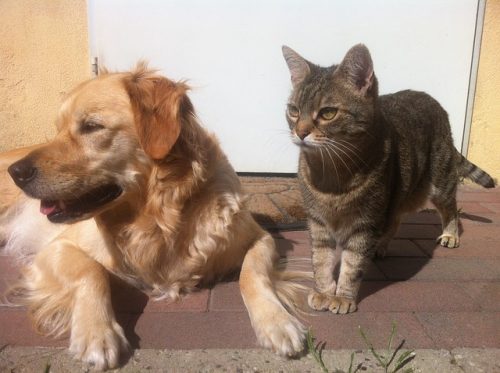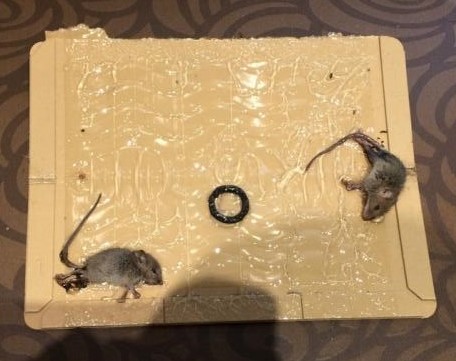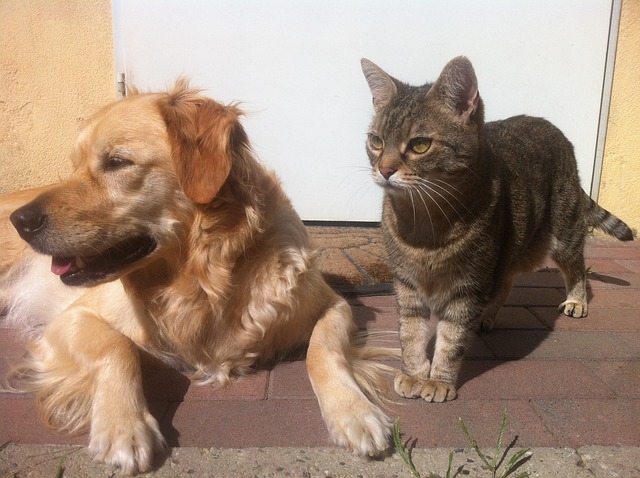Pet Safe Pest Control
Pest control activities are dangerous for all kinds of pets and certain measures to minimize the risks must be taken before, during and after pest extermination. Pest eradication activities quite often result in the death of domestic pets which fall victim to traps and poison, as sometimes it’s just impossible to ignore a rodent or bed bugs infestation at home. To guarantee the safety of domestic animals, follow this pet safe pest control guide which will teach you:
- What pesticides to use
- How to protect your pet from harmful substances
- What are the most common mistakes
- Additional tips on pet protection during treatments

Image Source: Pixabay.com Public Domain
Pet-friendly Pesticides
Most pesticides which are being used by pest control professionals have a very low concentration of toxins and are just deadly enough to deal with small insects but are totally safe for the pets and people that are exposed to them. For optimum safety, it’s still recommended to keep domestic animals away from the treated surfaces for few hours.
Mind that non-licensed service providers use hard chemicals which are devastating upon skin contact or after being inhaled. Use natural remedies for pest eradication if you want to feel 100% worry-free about your pet’s health.
Related: Tips to Grow a Pet-friendly Non-toxic Garden
Diatomite
Diatomaceous earth, also known as diatomite, has been used for roach extermination for decades and has proven to be very effective. It’s basically a white powder which contains fossilized remains of algae called diatoms. It’s 100% pet-safe unless it’s the one made for application in pools.
Buy only the standard food-grade diatomite if cockroaches have infested your property and apply all over where they’ve been spotted. They will drag the white dust into their nest and it will exterminate all cockroaches inside.
Pyrethrum

The dried flower heads of Chrysanthemum cinerariifolium are one of the most effective natural insect repellents and is widely used by skilled gardeners who know how to use it. If you don’t want to spend money on this, just grow several plants in your own yard and wait for the flower heads to grow, then dry them and crush the whole thing into dust.
Pyrethrum plants provide amazing pest protection from plants in the garden if just planted near flora threatened of insect infestation in the yard. The dust from the dry flower head can easily be turned into a home-made spray.
Be extremely careful with pyrethrum-based products sold in supermarkets, as most of these items consist of a small amount of pyrethrum dust mixed with highly toxic chemicals.
Ammonia
A mix of ammonia and water is a great natural remedy that will drive nearby rodents mad and will banish them for a long time.
Related: Keep Your Pets Safe From These Dangerous Pests
Strong pepper or garlic mix
A combination of onion, garlic, and jalapenos is a very efficient form of pet safe pest control. Mix these 3 with a sauce made from hot pepper and add some liquid soap. The whole mixture works best when combined with enough water so it can be easily applied on any surface. Your pet can hardly get hurt as it will stay away from it because of the smell, but importantly, it will also repel rodents.
Pet Safe Rodent Control
Rodent infestations are terribly devastating for buildings. Rats eat through walls in search of food and may even destroy electrical  installations, sewer pipes and drains. Therefore their eradication should be done as soon as possible.
installations, sewer pipes and drains. Therefore their eradication should be done as soon as possible.
Sadly, our pets often become victims of poison, glue boards and other pest control tools and gadgets. These tips will help you protect your pet while dealing with sneaky rodents.
- Eating through wires is one of the leading causes of fire inside buildings. Keep electrical installations safe by sealing them with metal, rat-proof plates.
- Use food for the traps which are not attractive to your pet. Avoid beacon and other meаt products if you have a dog or a cat.
- If glue boards are placed all around the property, keep domestic animals inside the building, away from the boards. Cats are highly vulnerable to glue boards and some have even died because of stepping onto them.
- Dispose of poisoned rodents immediately. Don’t let your pet consume dead mice or rats at any cost. This can give them toxoplasmosis, intestinal worms, or secondary poisoning.
- If a property is highly infested by rats, check your pet for marks of rat bites. An animal bitten by a wild rat may get rabies, which is quite often spread to people as well unless a rabies shot is taken.
- Before placing poison or traps for rodents, buy or make a DIY box of rigid material through which only a mouse or a rat will squeeze. The diameter of the hole should not exceed 4cm. Place the poison and traps inside and lure the vermin with food trails.
Pest Control Mistakes to Avoid
Some of the most common mistakes pet owners do are listed below. We highly recommend that you avoid them.
1. Using pest repellents made for humans on animals.
DEET is contained in pest repellents meant for people. Using it on pets may cause significant neurological damage.
2. Don’t treat cats and dogs the same way
When buying pest control products from the store, always read the information on the label – it will give you instructions on how to use it and whether it is suitable for the animal you want to use it on. It’s a common mistake to treat a cat with pyrethroids which impose a high risk of poisoning the cat. Always use the product for the animal species it is made for.
3. Observe your pet after being spot-on treated
After applying pet pesticides for spot-on treatment, always do follow-up checks of the treated places for any signs of redness, swelling or skin/hair loss. If you see such complications in addition to a decrease in appetite, take your pet to the vet immediately. Your pet might have been poisoned or infected.
4. Using Ultrasonic Devices
Some people use ultrasonic sound devices in an attempt to repel rodents away from the property. The things is, rats get accustomed to that noise pretty quick and it no longer bothers them. Overall, such devices can do harm to your dog, which is extra-sensitive to such high-pitched sounds, instead of scaring the rats.
5. Not Reading What’s on The Label
As mentioned before, labels are tremendously important. To become even more familiar with how to get the most of the information on the label, check this complete guide on all you need to know about pesticides label.
Related: Poisonous Pet Control: Know the Dangers
Additional Pest Control Tips to Protect Your Pet
- Use pet carriers or keep your pet in a kennel during the pest control procedure. No matter how “safe” the pesticides are, some companies do false advertising and may actually spray the property with highly dangerous substances.
- Take away all pet toys, bowls and items your pet uses from the premises that are about to be treated for pests.
- Do not be misled by baits and pest extermination products for snails which will be dug in the garden. Pets sense it and will easily dig it up and chew on it.
- Everything you put on your pet’s skin goes into his system and if it’s something poisonous, it will have an instant effect on the animal’s health.
- Water tanks for fish and bird cages should be protected at any cost during bed bug, and other bugs, treatment. It’s recommended to use soft towel or anything similar to prevent the animals from inhaling harmful substances.
~~~~~~
How To Protect Your Pet from Pest Control Dangers: Pet Safe Pest Control
About the Author:
 Matteo Grader is a content marketing executive for a pest control company in London. He graduated from the University of Westminster School of Media, Arts, and Design, where he studied Public Relations. Apart from creating relations between businesses and the public, Matteo is an avid fisherman and is most happy when he is surrounded by nature.
Matteo Grader is a content marketing executive for a pest control company in London. He graduated from the University of Westminster School of Media, Arts, and Design, where he studied Public Relations. Apart from creating relations between businesses and the public, Matteo is an avid fisherman and is most happy when he is surrounded by nature.
How To Protect Your Pet from Pest Control Dangers #dogs #PetSafety Share on X
![]()
A QUESTION FOR YOU:
What do you do to keep your pets safe during pest control procedures?
*** Leave your comment below. ***
(It’s just sexy!)

![]()
As always, thank you for taking the time to visit my blog!

♥ PEACE ♥
*
Disclosure: Animal Bliss is a Natural Wonder Pets affiliate and will earn a (very small) commission from purchases made through links on this website.
(Coffee money – thank you!)
😀
- 4 Tips for Maintaining Healthy Weight for Your Cat - December 20, 2019
- 8 Amazing Benefits of CBD for Dogs and Other Pets - December 12, 2019
- Kibble or Canned Pet Food? What Should Your Pet Be Eating? - December 9, 2019



Thanks for providing this informative article for us. when its come to your own house we have to know that the signs of pest problems and it’s crucial to control.
Hi Matteo,
These are some really good pointers on keeping pets safe. Pet safety is definately a big issue that very many people haven’t tapped into yet pets should just have the same treatment as humans and their protection is also as important.
hi,
where can i find some natural plants to prevent rat invasion around my dog hut ?